|
 GS.jpg) |
Melanotaenia trifasciata [Cato River, NT] - photo© Gunther Schmida |
(Rendahl, 1922)
Regal Rainbowfish
Species Summary
Melanotaenia trifasciata was discovered in June 1895 by Knut Dahl, a Norwegian Zoologist. The species description was published in 1922 by Hialmar Rendahl, on the basis of one single specimen from the Mary River, in the Northern Territory. Why he proposed the name trifasciata, meaning literally "three-banded", is not very obvious when you look at live specimens. However, it becomes clear when you bear in mind that Rendahl only knew this one museum specimen caught more than 20 years earlier. He described the colours as follows:
"The ground-colour of the fish is (in spirits) a light brown. Along the sides of the body, occupying the adjacent two-thirds of the scales, there is a broad blackish brown bar on the 5th and 6th longitudinal rows of the scales. ... On both sides, this dark bar is (except on the head) bordered by a very obvious light (in alcohol whitish), bar, the ventral of which is the broadest and about half the width of the dark one".
They are commonly known as the Banded Rainbowfish (Three-Striped Sunfish). However, I think they should be called the "Regal Rainbowfish" because they are without doubt the most majestic rainbowfishes you will ever see.
As with many rainbowfishes, the colouration of Melanotaenia trifasciata is variable depending on location, water conditions and diet. Populations from almost every river system where they are found have their own distinctive body colour. Consequently, specific names usually based on the locality where each is found are used by rainbowfish enthusiasts to identify each variety. They can be recognised by a very deep body, usually deeper than 1/3 of their body length, and an often discontinuous black mid-lateral band. Males are more brightly coloured, larger, and much deeper bodied than females.
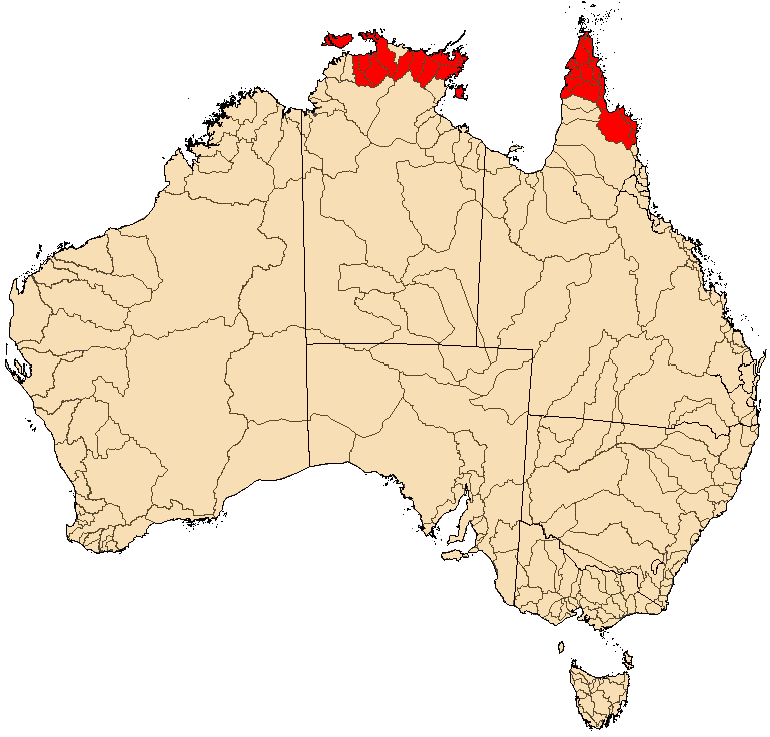 |
Distribution Map |
Distribution & Habitat
Melanotaenia trifasciata have a discontinuous distribution across northern Australia, from the Mary River in the Northern Territory, throughout Arnhem Land, around the Gulf of Carpentaria to Cape York Peninsula. In north Queensland they are found as far south as Gap Creek, north of the Bloomfield River. Specimens found in the Pascoe, Claudie and McIvor Rivers in Queensland are more streamlined and do not have the deeper body shape of their counterparts from other river systems. In 1989, some specimens were collected on Melville Island, the only offshore record thus far.
Melanotaenia trifasciata are a tropical fish, and occur in almost every kind of freshwater habitat, from slow-moving streams, wetland swamps, lagoons and clear flowing rivers. They are most common in flowing waters or in streams where water flow is present for much of the year. Melanotaenia trifasciata are most frequently found in clear waters with sandy substrates, followed by rocks, leaves and mud. In these habitats they are commonly found around sub-surface vegetation, submerged logs, or branches. Depth of waters in which Melanotaenia trifasciata are mostly found range from 30 to 200 cm. They are often found inhabiting the same streams with Melanotaenia nigrans, M. maccullochi and M. splendida inornata. Their natural environment is subjected to seasonal variations with water temperatures ranging between 24° Celsius during the dry season and up to 33° Celsius in the wet season. The water is generally alkaline (pH 7.2-8.0); however, they are occasionally found in acidic conditions (pH 6.5-6.9).
Many Australian freshwater fish species have evolved to survive under a wide range of environmental conditions, and those conditions and the habitats created can change dramatically over time. Part of the reason for this is that Australian freshwater fish have adapted to live in variable and unpredictable environments, and so have not developed the strong habitat associations that are characteristic of highly specialised fish in more predictable river systems in other countries. Not surprisingly, the largest and healthiest populations of a species will generally be found where the conditions are closest to optimal for all the water quality factors.
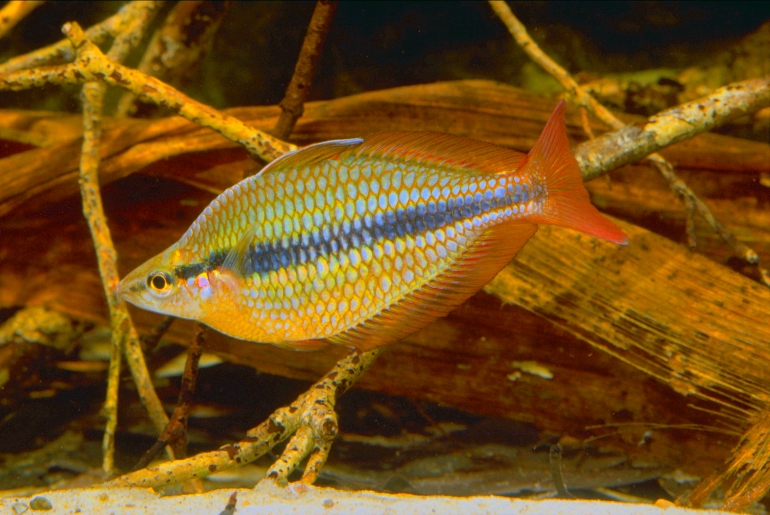 |
Melanotaenia trifasciata [Running Creek, Weipa] - photo© Gunther Schmida |
Biology & Ecology
Very little is known about the biology of this species in their natural environment. Most information is mainly based on aquarium observations. Melanotaenia trifasciata are sexually dimorphic. In males, the spines of the first dorsal are usually extended and may lie well past the origin of the second dorsal when not erect. The posterior rays of the second dorsal and anal fins are extended caudally and may extend past the origin of the caudal fin. In females, the first dorsal spines are short, not reaching the origin of the second dorsal. The posterior rays of the anal and second dorsal fin are not extended. The spines and outer rays of the ventral fins of some males are also extended and may reach past the vent and the origin of the anal fin.
Melanotaenia trifasciata characteristically display a considerable range of growth rates, depending on conditions such as food, space, numbers, competition and water temperature. In tropical waters, which have prevailing high temperatures, fish generally grow faster, mature younger, and have a shorter life span than fish in temperate waters. Melanotaenia trifasciata may reach a maximum size of 15 cm, but are usually less than 12 cm, with a body depth of 6-8 cm. Males are deeper bodied than females and the overall colour pattern of males is more intense. The vertical fins of females are either translucent or only faintly coloured compared to the brighter colours of males. These features become more obvious with increased growth.
Melanotaenia trifasciata are aseasonal spawners, breeding continuously at intervals throughout the year. Therefore it is difficult to define their breeding season. However, a peak in reproductive activity is usually during the early-wet season. The breeding season must coincide with the conditions that offer the greatest amount of protection for the eggs, and food and shelter for the newly hatched young. The duration and timing of reproductive activity are thus two critical components for their continual survival.
Fortunately, rainbowfishes in captivity are very adaptable and will breed under a variety of conditions. Therefore, maintaining them in an appropriate aquarium environment will ensure successful breeding. Under aquarium conditions they can be induced to spawn throughout the year by the manipulation of water temperature and photoperiod. They are relatively fast growing, reaching sexual maturity before the end of their first year.
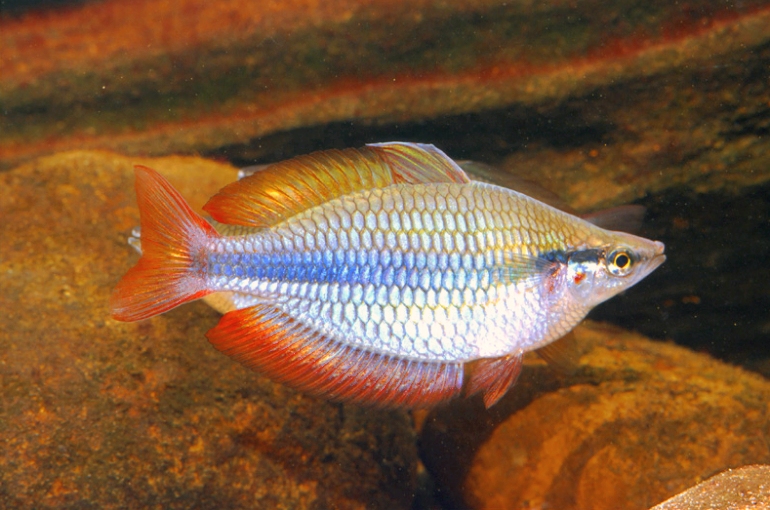 |
Melanotaenia trifasciata [Gap Creek, Qld] - photo© Gunther Schmida |
Males display to each other by extending their dorsal and anal fins, while at the same time intensifying their colouration. The extension of the fins is an illusionary aspiration by the males to increase their overall body size as they complete with each other for the attention of a female. This is often accompanied by a side-slapping action while swimming together side by side throughout the aquarium. Extended fin and colour intensity is also undertaken by the male when displaying to a female, only this time it is an attempt to increase their overall attractiveness to the females.
Spawning males display with their dorsal and anal fins raised while actively pursuing a female. Males frequently "flash" an instantaneous brightly coloured band that runs from the upper lip to the first dorsal fin, which they flash on and off like a neon sign. The colours range from white to yellow, orange, rustic red and light blue, depending on the species. Spawning generally occurs during the early morning hours, preceded by vigorous coercing by the male. The male swims around the female with all his fins expanded, making repeated sideways motions or "nods" in the direction of the female. When receptive, the female will enter the spawning site first, closely followed by the male. He presses against the side of the female and, accompanied by much trembling action from both fishes, eggs are expelled directly among the plants or spawning medium.
Females produce between 200 and 500 eggs, spawning a number of times daily for several days or opportunistically whenever conditions are favourable. Large females usually produce more than 50 eggs per day for several days. Smaller females, which are only just sexually mature, shed fewer eggs, 20-30 per day and spawning does not occur daily. The eggs are attached by adhesive threads or tendrils to aquatic plants or artificial substitutes. The eggs are large (average 1.5 ± 0.5 mm in diameter); clear to light amber in colour. After spawning, the female will leave, while the male remains displaying to passing females and thus defending his territory and the fertilised eggs. Depending on temperature hatching will occur 6-7 days after spawning.
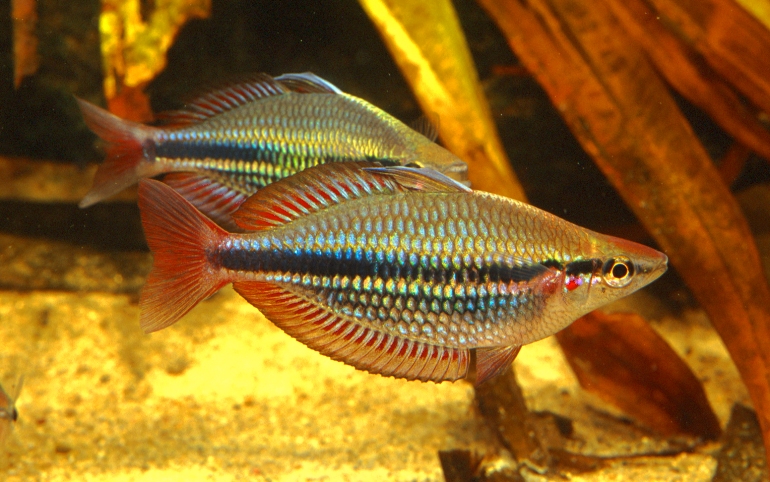 |
Melanotaenia trifasciata [Olive River, Qld] - photo© Gunther Schmida |
Melanotaenia trifasciata is an omnivore feeding opportunistically in the surface and mid-water regions. In sunny conditions shoals of juveniles occurred near the water surface, but larger fish tend to occur in the mid-water region near submerged vegetation, often utilising aquatic plants as a refuge and food source. Under cloudy conditions, however, fish of all sizes preferred deeper water. The main food items are aquatic insects, algae and terrestrial insects such as green ants (Oecophylla smaragdina), which presumably fall on to the water surface from overhanging vegetation. The diet varies in relation to the habitat they occupy. In the mainchannel waterbodies they eat mainly aquatic insects, with small amounts of terrestrial insects, plant material and algae. In perennial streams, algae and terrestrial plant material are less important, while aquatic insects and, to a lesser extent, oligochaetes and microcrustaceans, are consumed. The diet in the lowland sandy creekbeds has much larger algal and terrestrial insect components. Specimens examined from the floodplains feed mainly on aquatic arachnids and aquatic insects, and a small amount of algae. Planktonic invertebrates (mostly zooplankton) are importance in their early life history stages. The availability of appropriate zooplankton is an important determinant of mortality levels endured by larval fish populations and thus is an important determinant of recruitment into the adult population.
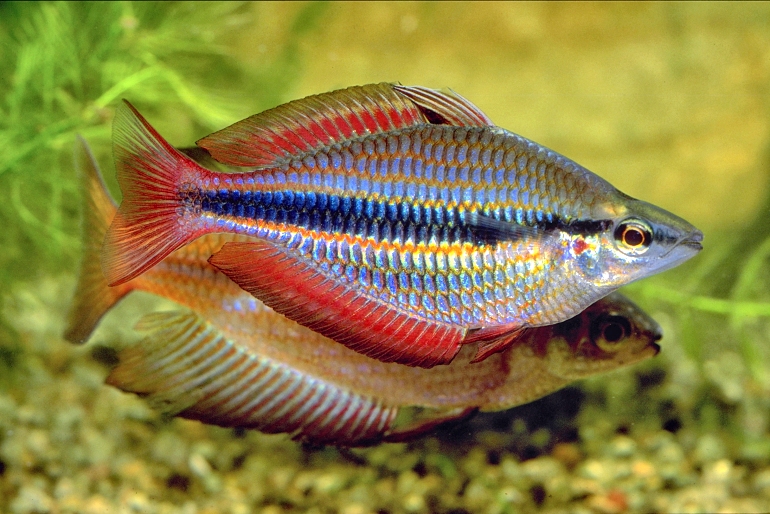 |
Melanotaenia trifasciata [Rocky Bottom Creek, Goyder River, NT] - photo© Gunther Schmida |
Remarks
Due to the diversity of range and habitat, there are many colour variations in the trifasciata group. The most appealing is the variety found in the Goyder River in Arnhem Land (above). This species was first introduced to the aquarium hobby back in the early 1970's. Wally Muller, a well-known aquarium dealer in those days obtained a few during his visit to the Northern Territory to collect aquarium specimens. He obtained permits from the Fisheries and Wildlife Department, and was able to bring back some fine specimens to Brisbane where he had his retail business. When first introduced to the aquarium hobby in Brisbane, the Goyder River rainbowfish created quite a deal of excitement. At a public aquarium exhibition, where they made their first public appearance, the cover glass was glued to the aquarium proper so that no one would be able to steal them. Since then, there has been many new colour varieties differing from one another though small variations in colour, morphology and meristics that are found in various habitats in northern Australia and today they number around thirty-five. Melanotaenia trifasciata may undergo species separation after further genetic studies.
Literature
Allen G.R. (1989). Freshwater fishes of Australia. T.F.H. Publications, Inc., Neptune City, New Jersey.
Rendahl H. (1922). A contribution to the ichthyology of north-west Australia. Nyt Magazin for Naturvidenskaberne, Kristiania 60: 163-197.
Adrian R. Tappin
Updated April, 2013



|
|

